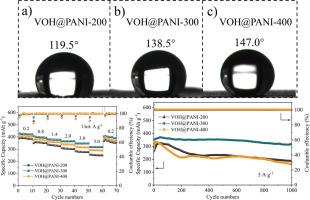In-situ polymerization polyaniline-coating of V10O24·nH2O (VOH) for enhanced zinc-ion battery performance
IF 5.6
3区 材料科学
Q1 ELECTROCHEMISTRY
引用次数: 0
Abstract
Recognized for their safety and low cost, aqueous zinc-ion batteries (AZIBs) hold significant promise for large-scale energy storage fields. Layered vanadium-based compounds offer attractive AZIBs cathodes with open crystal structures, high theoretical specific capacity, and resource abundance. However, they often suffer from vanadium dissolution and poor cycling stability caused by corrosion from free water molecules. To address these issues, polyaniline-coated V₁₀O₂₄·nH₂O (VOH@PANI) was synthesized via in-situ polymerization strategy. The conductive PANI coating not only enhances the electrical conductivity of composite, but also induces an amorphous structure transformation, thereby improving the rate capability. Furthermore, the polyaniline coating increases the material's hydrophobicity, effectively suppressing vanadium dissolution and enhancing electrochemical stability. Benefiting from this modification, the fabricated VOH@PANI-300 electrode delivers a specific capacity of 424.09 mAh g⁻¹ at 0.2 A g⁻¹ and maintains 314.51 mAh g⁻¹ after 1000 cycles at 5 A g⁻¹, corresponding to a capacity retention of 89.70 %. These results markedly surpass the uncoated VOH electrode (348.12 mAh g⁻¹ at 0.2 A g⁻¹, 39.62 % retention after 1000 cycles at 5 A g⁻¹. This work establishes a viable approach for preparing high-performance vanadium-based cathode materials of AZIBs.

原位聚合聚苯胺- V10O24·nH2O (VOH)涂层提高锌离子电池性能
水性锌离子电池(azib)因其安全性和低成本而得到认可,在大规模储能领域具有重要的前景。分层v……
本文章由计算机程序翻译,如有差异,请以英文原文为准。
求助全文
约1分钟内获得全文
求助全文
来源期刊

Electrochimica Acta
工程技术-电化学
CiteScore
11.30
自引率
6.10%
发文量
1634
审稿时长
41 days
期刊介绍:
Electrochimica Acta is an international journal. It is intended for the publication of both original work and reviews in the field of electrochemistry. Electrochemistry should be interpreted to mean any of the research fields covered by the Divisions of the International Society of Electrochemistry listed below, as well as emerging scientific domains covered by ISE New Topics Committee.
 求助内容:
求助内容: 应助结果提醒方式:
应助结果提醒方式:


